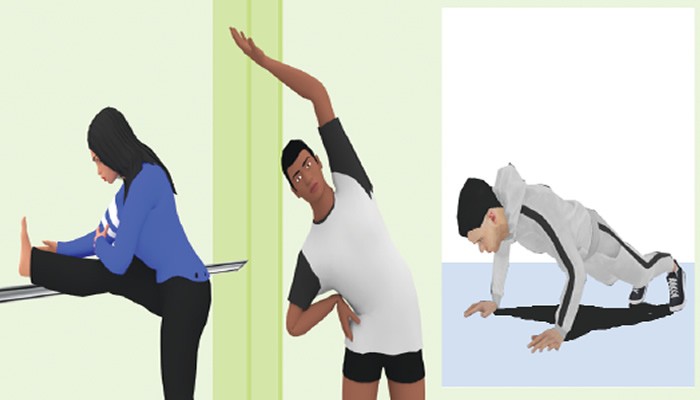8 ways to maintain healthy spine
The chassis of a car is its main supporting structure to which all other components are attached. The human spine or backbone, in the same vein, is the body’s central support structure that connects the muscles, bones, tendons, ligaments and soft tissues. The spine helps to keep the head, trunk and legs aligned and balance the neck, chest, lower back, and pelvis.
Whenever you can sit, stand, walk, twist and bend, your spine and other organs help you do that. It is the house that encases the spinal cord.
Therefore, injury, spinal cord conditions, poor posture, infections, arthritic conditions, inactivity, too much sitting, over-exertion or use, and other problems can damage the spine and cause severe neck and back pain.
According to the Chief Executive Officer of the Institute of Exercise Professionals, Joel Uzamere, there are several types of spine deformities, namely, scoliosis, kyphosis, and lordosis.
He explains that scoliosis is when the spine curves sideways in a C-shape and by genetics or a neuromuscular disorder. Unfortunately, exercise can do very little to restore proper posture in this condition.
Uzamere adds, “Kyphosis is when the upper spine curves forward, leading to a hunchback appearance. It is usually caused by poor posture or weak bones. This condition can be reversed with proper exercise and a change of lifestyle.
“The average person spends a little above five hours daily on their mobile phones and more hours bending over their personal computers. This prolonged posture puts a strain on the spine, especially the upper part (thoracic) which causes the deformity called Kyphosis.
“Lordosis is when the lower spine curves inward, leading to an excessive arch in the lower back. It is usually caused by poor posture, obesity or pregnancy.”
A team of health and well-being specialists, The Good Body, states that 540 million people, globally, suffer from back pain. It also states that nearly four in 10 office workers will experience back pain.
Medical experts say that strong back muscles can protect the spine and prevent spine problems.
Back strengthening and stretching exercises bi-weekly are a few ways to strengthen the abdominal, side and back muscles and make the spine healthy.
Here are eight other ways to maintain a healthy spine
Good posture
Uzamere says that maintaining a good posture is the key to keeping one’s spine healthy and strong. This is because a healthy spine has three natural curves that form an S-shape, so when there is usually pressure or a part of the body is twisted or bent in an unnatural shape, it causes pain and sprains the spine.
He adds, “Be conscious of your posture when you’re working on your personal computer and when with your phone. Always keep your back straight, shoulders back with your ears parallel to your shoulders.”
Proper sleep posture
It is advisable to sleep on your side, which is similar to sleeping in a fetal position, and place a pillow under your neck and between your knees.
Sleeping on your back is one of the best sleeping positions as it promotes better alignment and reduces the pressure on your arms and legs.
To do this, place a pillow under your neck and knees to keep your legs relatively extended.
Nutrition
Maintaining a consistently healthy diet ensures that the body and other organs are nourished.
Uzamere notes, “Eat calcium-rich foods and take vitamin D. Good sources of calcium include milk, fish, bread, nuts, etc. If you find it difficult to get enough calcium from your diet, ask your doctor about supplements.”
A healthy diet also helps to ensure a healthy weight.
“Excess weight can put added stress on the spine and increase the risk of back pain,” he warns.
It is also advisable to opt for healthy anti-inflammatory foods because they are low in calories and reduces the risk of excessive weight gain.
Proper posture during chores
A professor of physiotherapy at the Obafemi Awolowo University, Rufus Adedoyin, states that spending long hours on house chores in positions that are not conducive to the spine is unhealthy to the spine and causes neck and back pain.
He advises, “Instead of using a short broom, get a long broom that will not allow excessive bending of the trunk. When washing clothes, don’t put the bucket on the ground where you would have to bend to wash them. Put the bowl on a high platform which will allow you to stand. Cooking utensils should also be placed on a high platform to promote standing while doing the chores.”
It is advisable that when washing plates in a kitchen sink or elevated platform, both legs should be placed on the floor with the trunk erect.
Regular exercise
Exercises, especially weight-bearing exercises can help to strengthen the muscles that support the spine, including the back and abdominal muscles. Uzamere says, “Incorporate exercises like yoga and low-intensity cardiovascular workouts into your routines which help to strengthen the spine.”
He advises that the services of a qualified and certified fitness professional should be sought before beginning an exercise routine.
“They will teach you how to complete your routine with a good posture and technique,” the GP Referred Master Trainer says.
Also, maintain a steady routine of stretching and strengthening; this will help to manage and control pain in the spine.
Lift heavy weights with proper technique
Uzamere says, “When lifting heavy objects, use proper technique to avoid straining the spine. Keep your back straight, bend at the knees, and use the muscles in your legs to lift the object.”
Use ergonomic desks and chairs
“Whether at work or home, use furniture and equipment designed to support the spine and promote good posture. This may include an ergonomic chair, adjustable desk, or supportive mattress,” Uzamere says.
The physiotherapist adds that the foam in the mattresses, couches, and chairs should not sag but be firm.
Take breaks
Persons who spend long periods sitting or standing should take regular breaks to stretch, walk, or change positions. This can help to prevent stiffness and reduce the risk of back pain.








